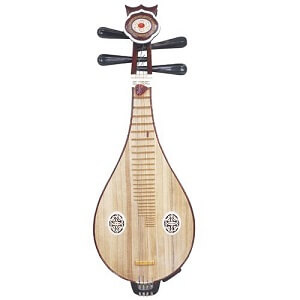Liuqin
 The shape of the liuqin looks like a “liu (willow) leaf”, hence its name. It is also commonly called “tu pipa” and “jingang tui” and is a popular instrument in Shandong, Anhui and Jiangsu. The liuqin is the principal accompanying instrument for the Liuqin Opera common in southern Shandong and northern Jiangsu, the Sizhou Opera of Anhui, and Shaoxing luantan of Zhejiang. Originally the liuqin was an alto instrument fitted with two strings and seven frets. It was reformed into a soprano plucked instrument with four strings and twenty-nine frets in the 1950’s as a need of the Chinese ensemble. Its range is as wide as four octaves, comparable to that of a violin. Its tone quality is solid in the low register, tender in the middle register and sonorous in the high register with strong penetrating power. It is a plucked-string instrument for playing high-pitched melodies, has exuberant expressions and is hailed as the “gem” of Chinese orchestras. One of the representative pieces for solo is Spring Comes to River Yi.
The shape of the liuqin looks like a “liu (willow) leaf”, hence its name. It is also commonly called “tu pipa” and “jingang tui” and is a popular instrument in Shandong, Anhui and Jiangsu. The liuqin is the principal accompanying instrument for the Liuqin Opera common in southern Shandong and northern Jiangsu, the Sizhou Opera of Anhui, and Shaoxing luantan of Zhejiang. Originally the liuqin was an alto instrument fitted with two strings and seven frets. It was reformed into a soprano plucked instrument with four strings and twenty-nine frets in the 1950’s as a need of the Chinese ensemble. Its range is as wide as four octaves, comparable to that of a violin. Its tone quality is solid in the low register, tender in the middle register and sonorous in the high register with strong penetrating power. It is a plucked-string instrument for playing high-pitched melodies, has exuberant expressions and is hailed as the “gem” of Chinese orchestras. One of the representative pieces for solo is Spring Comes to River Yi.
“Liu“ in Chinese means willow. “Qin“ means music instrument. The name “Liuqin“ comes from the fact that the instrument is made of willow wood and shaped like a willow leaf. The earliest precursor of the modern four-stringed Lingqin appeared and experienced popularity during the Tang Dynasty (AD 618 - 907). It has been an accompaniment instrument in folk Chinese opera and in narrative music for much of dynastic China. The modernization of Liuqin in 1970s resulted in a gradual elevation in status of liuqin to an instrument well-appreciated for its unique tonal and acoustic qualities. Crisp and bright, the Liuqin is the highest-pitched member of the plucked strings but its volume is small. It is capable of producing an exciting and agitating tune when played loudly, and a sweet and touching tune when played softly.